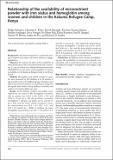| dc.contributor.author | Philip Ndemwa, Christine L Klotz, David Mwaniki, Kai Sun, Erastus Muniu, Pauline Andango, Joyce Owigar, Jee Hyun Rah, Klaus Kraemer, Paul B Spiegel, Martin W Bloem, Saskia De Pee, Richard D Semba | |
| dc.date.accessioned | 2020-08-17T07:51:54Z | |
| dc.date.available | 2020-08-17T07:51:54Z | |
| dc.date.issued | 2011-09 | |
| dc.identifier.uri | https://repository.maseno.ac.ke/handle/123456789/2139 | |
| dc.description.abstract | Background
Micronutrient powder is a potential strategy to improve iron status and reduce anemia in refugee populations.
Objective
To evaluate the effect of the availability of home fortification with a micronutrient powder containing 2.5 mg of sodium iron ethylenediaminetetraacetate (NaFeEDTA) on iron status and hemoglobin in women and children in the Kakuma Refugee Camp in northwest Kenya.
Methods
Hemoglobin and soluble transferrin receptor were measured in 410 children 6 to 59 months of age and 458 women of childbearing age at baseline (just before micronutrient powder was distributed, along with the regular food ration) and at midline (6 months) and endline (13 months) follow-up visits.
Results
At the baseline, midline, and endline visits, respectively, the mean (± SE) hemoglobin concentration in women was 121.4 ± 0.8, 120.8 ± 0.9, and 120.6 ± 1.0 g/L (p = .42); the prevalence of anemia … | en_US |
| dc.publisher | SAGE Publications | en_US |
| dc.subject | Anemia, children, hemoglobin, iron, micronutrient powder, refugees, women | en_US |
| dc.title | Relationship of the availability of micronutrient powder with iron status and hemoglobin among women and children in the Kakuma Refugee Camp, Kenya | en_US |
| dc.type | Article | en_US |

